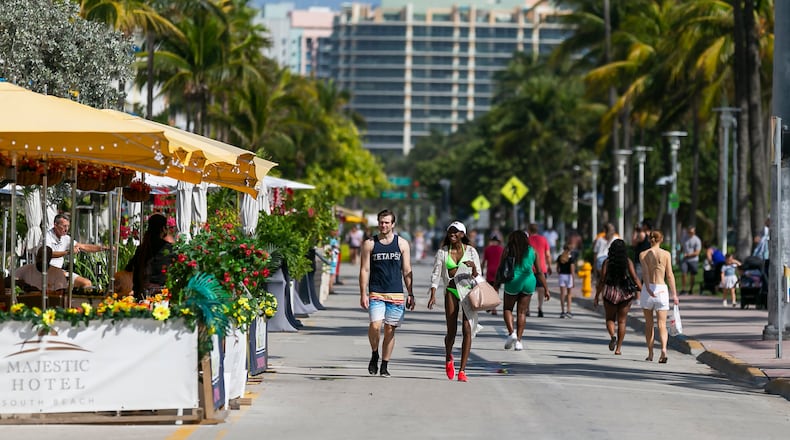MIAMI — Whether swaying in the background of a Super Bowl glamour shot or printed on Art Deco-themed postcards, palm trees are synonymous with the sun-and-fun allure of Miami Beach. In a city with nearly 50,000 trees, more than half have fronds.
But because of rising temperatures, that’s about to change.
To help address the consequences of climate change, city leaders will cut back on the number of new palms in the city and add more eco-friendly shade trees to the Beach’s canopy.
Guided by an urban forestry master plan, which the Miami Beach City Commission unanimously approved in October, city officials are working to reduce the concentration of palms to 25% of the total canopy by 2050. The city says the cutback — intended to help reduce urban warming, improve air quality and absorb more carbon and rainwater — will be accomplished during upcoming construction projects that already require the removal of trees, partly by removing some palms but mostly by adding new shade trees.
“Palms, while an iconic part of Miami Beach’s landscape, have moved from being an accent plant to a major component of the city’s urban forest,” the urban forestry master plan reads.
The execution of the plan has alarmed one city commissioner, who recoiled at a January memo that announced the coming removal of 1,000 palms. But Elizabeth Wheaton, the city’s environmental and sustainability director, told The Miami Herald the city is not just going around chopping down palm trees.
“Expanding shade canopy will enhance the city’s brand and quality of life,” Wheaton wrote in an email. “Palms will continue to be a focal point along the city’s roads, greenspaces and parks.”
During the next 20 years, Wheaton said the city aims to plant more than 1,300 new shade trees per year. New shade trees will be added around existing palms to make the city more walkable and pleasant, she said, adding that trees including the royal poinciana and gumbo limbo “reduce the heat island effect, uptake carbon and rainwater, and improve air quality.”
It’s unclear how many fewer palm trees Miami Beach may have in the coming decades, but Wheaton noted that the percentage of palms could be reduced by exclusively adding shade trees to the existing population.
Currently, the city has 22 active projects that require the removal of palms and trees. More than 1,000 palm trees are slated for removal, but 891 new ones will be planted. Nearly 500 shade trees will be removed under the projects but close to 900 will be added. The city code requires that any palms or other trees affected by redevelopment must be replaced with new shade trees.
“Expanding shade canopy will enhance the city's brand and quality of life. Palms will continue to be a focal point along the city's roads, greenspaces and parks."
“Palms are not actively being removed, rather canopy trees are being prioritized for planting to increase the city’s tree canopy percentage citywide to maximize environmental, social and economic benefits of trees,” Wheaton said.
But talk of removing palm trees has created some friction.
Miami Beach Commissioner Steven Meiner has come out against the policy in recent weeks. He casts the program as a mass removal of palms that will damage the Beach brand and has rallied some residents behind his cause.
At Meiner’s request, the city will hold a video meeting March 2 at 4 p.m. to discuss the plan and hear from residents.
“The removal of so many iconic, beautiful palm trees, including royal palms, will have a negative impact on our historic, cultural and economic brand,” Meiner wrote in an email. “Millions of tourists throughout the U.S. and the world annually visit Miami Beach and palm trees are an integral part of our brand. There are only a handful of tropical climates in the United States where palm trees can grow.”
He has posed for photos at North Beach Oceanside Park, where the city is removing or relocating 51 palm trees as part of the park’s redevelopment. The city is adding 29 new palm trees and 15 shade trees to the park. The nearby beachwalk project will involve the removal of 183 palms and the addition of 433 shade trees.
Meiner voted for the master plan in October, but now says it did not include specifics about how many trees were to be removed. Meiner said he became concerned after Interim City Manager Raul Aguila detailed in a January memo that more than 1,000 palms would be removed as part of the active city projects.
One possible point of confusion: Aguila’s memo says the forestry master plan calls for “reducing and replacing the overall number of palms” to cut down their numbers in the coming decades. Wheaton now says the memo was unintentionally misleading. The forestry master plan, she said, does not explicitly recommend removing palm trees.
“The statement was incorrect and will be fixed in the memo for the workshop,” Wheaton said earlier this week, adding the city’s goal is to add scores of shade trees so that they “once again become the predominant form of canopy.”
Aguila stressed that changing course now could make ongoing projects more expensive.
“Another thing to consider is changing direction midstream may affect projects that are being designed in according with the Master Plan, resulting in costly change orders and projects delays,” he wrote in a text message.
Meiner said he has met with forestry experts who share his concern. His aide, Amadeus Huff, has drummed up support for changing the policy on Facebook, urging residents to call into the workshop to “raise your concerns.”
“They are removing our brand, our identity,” Huff wrote in one comment. “If this plan goes forward, they might as well remove the palm from our City’s official logo.”
About the Author
Keep Reading
The Latest
Featured

